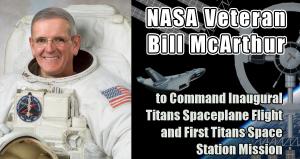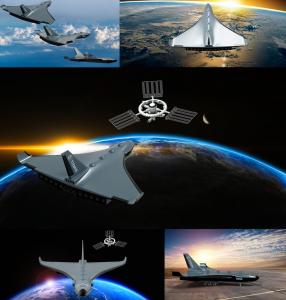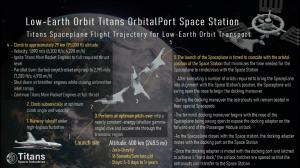
NASA Veteran Bill McArthur to Command Inaugural Titans Spaceplane Flight and First Titans Space Station Mission
Bill McArthur has flown on a Soyuz spacecraft (2005) and three different NASA spaceplanes: Columbia (1993), Atlantis (1995), and Discovery (2000).
McArthur brings a wealth of invaluable experience to TSI, having served with distinction at NASA for three decades. A veteran of three Space Shuttle missions (STS-58, STS-74, and STS-92) where he served as mission specialist and flight engineer, and a six-month expedition as Commander of the International Space Station (ISS) via the Soyuz TMA-7 spacecraft (where he served as co-pilot), McArthur has logged over two hundred days in space, including four spacewalks and extensive work in microgravity environments. His deep understanding of space operations, safety protocols, and leadership in complex orbital environments makes him the ideal commander for the first crewed mission to TOPSS.
The Titans OrbitalPort Space Station (TOPSS) represents a revolution in orbital infrastructure, envisioned as a versatile hub that integrates multiple functionalities. Beyond serving as a platform for long-duration astronaut habitation and cutting-edge microgravity research, TOPSS will also incorporate advanced space manufacturing capabilities, allowing for the in-orbit production of high-value materials and products. Furthermore, a dedicated section will function as a commercial space hotel, offering unique short-term accommodations for researchers, private citizens, and space explorers seeking the unparalleled experience of living and working in orbit. This multi-faceted design aims to maximize the utility and economic viability of the space station.
The architecture of the Titans OrbitalPort Space Station (TOPSS) offers significant advantages over traditional space station designs. Connected by secure airlock tunnels, the initial configuration will comfortably accommodate 24 astronauts, with the inherent flexibility to expand to 48 and eventually 72 or more simultaneous occupants by adding further structures. This design not only enhances safety by allowing for the isolation of individual sections in case of emergency, but also provides adaptable space for the station’s diverse roles as a research and development center, a manufacturing facility, and a space hotel. While the first generation of TOPSS will operate in a microgravity environment, consistent with the ISS, TSI is committed to the future development of a space station with artificial gravity to support longer-duration missions and a wider range of human activities in space.
Joining McArthur on this historic first TOPSS mission will be a distinguished group including TSI’s Chief Astronaut Chris Sembroski, Dr. Mindy Howard (Astronaut Trainer and Human Factors Specialist), and Vaseema Hussain (TSI’s Director of Space Sustainability and Astronaut Liaison), among other talented individuals.
Bill McArthur expressed his enthusiasm for this new chapter: "I am incredibly excited to join the innovative team at Titans Space Industries. Their commitment to reusable spaceflight and their bold vision for orbital infrastructure, particularly the single-stage-to-orbit and horizontal takeoff and landing spaceplane and the multi-functional design and multi-purpose concept of the Titans space station to enable science and space manufacturing at scale, represent a paradigm shift for the space sector. Commanding the first spaceplane flight and space station mission is a tremendous honor, and I will be working alongside our exceptional crew to establish a thriving hub for research, collaboration, and expanded permanent human presence in low Earth orbit and beyond."
Neal S. Lachman, CEO of Titans Space Industries, stated, "Having a veteran astronaut and leader of Bill McArthur’s caliber join the inaugural spaceplane and space station missions as commander is a momentous occasion. Bill has flown on Soyuz and three different NASA spaceplanes: Discovery, Atlantis, and Columbia. His broad experience in spaceflight and his deep understanding of orbital operations are invaluable as we embark on our ambitious projects to establish the Titans OrbitalPort Space Station and the spaceplanes as its transportation vehicle. Bill’s leadership will be essential in ensuring the success and safety of the inaugural spaceplane flight and space station mission; we are honored to have him as commander and part of the TSI family."
TSI's Chief Astronaut Chris Sembroski added, "It's an honor to welcome Bill McArthur to TSI and to see him fly on the first Titans spaceplane and TOPSS missions. His experience on the Space Shuttle and the ISS is incredibly inspirational for the team. These two inaugural missions mark the beginning of a new era of accessibility to space, and Bill’s mentorship will continue to pave the way."
Dr. Mindy Howard, TSI Astronaut Trainer and Crew Member, commented: “The human element is absolutely critical in both short- and long-duration space missions. The innovative design of TOPSS, with its potential for larger crews and diverse activities, opens exciting avenues for research in human factors and mental preparedness in space. I’m honored to be part of the inaugural missions under the exceptional leadership of Bill McArthur, first aboard the groundbreaking Titans Genesis Spaceplane, and then to TOPSS, where I’ll focus on supporting the well-being and optimal performance of future space station astronauts.”
Vaseema Hussain, TSI’s Director of Space Sustainability and Astronaut Liaison, added, "Welcoming Bill McArthur to the TSI team and the inaugural TOPSS crew is a significant step towards realizing our vision of a more sustainable and accessible space ecosystem. His experience, coupled with the innovative design of TOPSS as a research, manufacturing, and habitation hub, creates a powerful platform for advancing in-space activities. I am particularly excited about the collaborative potential this larger station offers and look forward to flying alongside him."
Marcus Beaufort, TSI’s Director of Business Strategy and R&D stated: "The EarthLoop flights on the Titans spaceplanes will provide unique opportunities for short-duration microgravity research, offering approximately three hours of valuable R&D time. This capability complements the long-duration research that will be conducted on the Titans OrbitalPort Space Station, allowing for a comprehensive approach to understanding the effects of weightlessness and advancing various scientific and industrial applications. We are proud and honored to have Bill McArthur lead our two inaugural missions as commander and lead this revolution in the field of space R&D."
Spaceplane and Space Station Operations
The Titans Spaceplane is specifically designed to provide safe, reliable, efficient, and low-cost transportation for astronauts and cargo to and from the Titans OrbitalPort Space Station. Much like NASA’s Space Shuttle ferried astronauts and supplies to and from Low Earth Orbit, the Titans spaceplanes will perform a similar function, with a key difference: the Titans Spaceplane is a Single-Stage-To-Orbit (SSTO), Horizontal Takeoff and Horizontal Landing (HTHL) vehicle, while the Space Shuttle utilized a vertical takeoff configuration. This unique design dramatically increases safety (because there are no explosive take offs and stage separations) for the crew, streamlines operations and rapid reusability, and significantly reduces the cost per flight compared to traditional rocket systems.
The Inaugural spaceplane flight is followed by frequent dedicated EarthLoop missions, providing an unprecedented platform for short-duration microgravity research. These EarthLoop flights are unique in that virtually all passengers aboard will be research crew, participating in a diverse array of scientific experiments. Each EarthLoop mission offers approximately three hours of sustained microgravity, a duration ideally suited for a wide range of scientific investigations.
This capability complements the long-duration research conducted on the Titans OrbitalPort Space Station, enabling a comprehensive understanding of microgravity's effects across varying timeframes. The scale of EarthLoop operations, with frequent flights carrying large numbers of research crew, represents a seismic shift in the accessibility of microgravity, revolutionizing fields such as materials science, biotechnology, and pharmaceuticals. By dramatically increasing the volume of microgravity research, EarthLoop and TOPSS missions will help accelerate the development of new technologies, medicines, and manufacturing processes.
Recognizing the growing demand for access to LEO, Titans Space Industries is offering comprehensive 1-month all-inclusive mission packages to companies, space agencies, and research institutions for a fixed price of $25 million. Each package includes transportation for two astronauts to and from TOPSS aboard a Titans Spaceplane, as well as accommodation and support within the station for the duration of the mission. This offering provides a cost-effective and streamlined pathway for organizations to conduct research, perform manufacturing processes, or gain firsthand experience in the unique environment of low Earth orbit.
The inaugural launch of the crew to the Titans OrbitalPort Space Station aboard a Titans Spaceplane under McArthur's command is targeted for Q4 2029, following McArthur’s flight, also as commander, on an earlier Titans Genesis flight in March 2029.
About William S. “Bill” McArtur Jr.
A veteran of four spaceflights and a retired U.S. Army Colonel, William S. "Bill" McArthur Jr. has had a distinguished career marked by extensive experience in aviation, engineering, and space exploration. His trajectory took him from the rigorous training environments of the U.S. Army and test pilot school to serving as commander of the International Space Station.
Born on July 26, 1951, in Laurinburg, North Carolina, McArthur's hometown is Wakulla, North Carolina. He graduated from Red Springs High School in 1969. His pursuit of knowledge and service led him to the United States Military Academy at West Point, where he earned a Bachelor of Science degree in Applied Science and Engineering in 1973. He continued his academic pursuits, obtaining a Master of Science degree in Aerospace Engineering from the Georgia Institute of Technology in 1983.
McArthur's military career in the U.S. Army was extensive and varied. Following his commissioning in 1973, he served with the 82nd Airborne Division at Fort Bragg, North Carolina. He attended the U.S. Army Aviation School, graduating as the top student in his flight class in 1976 and earning his designation as an Army aviator. His military assignments included serving as an aeroscout team leader and brigade aviation section commander with the 2nd Infantry Division in the Republic of Korea. He later served in the 24th Combat Aviation Battalion in Savannah, Georgia, holding positions as a company commander, platoon leader, and operations officer. After earning his master's degree, he returned to West Point as an assistant professor in the Department of Mechanics. In 1987, he graduated from the U.S. Naval Test Pilot School and was designated an experimental test pilot. He is also qualified as a Master Army Aviator, accumulating over 9,000 flight hours across 41 different aircraft and spacecraft during his career. He retired from the U.S. Army in 2001.
McArthur's long and impactful association with NASA began in August 1987 when he was assigned to the Johnson Space Center as a Space Shuttle vehicle integration test engineer. In this role, he was involved in the engineering liaison for Space Shuttle launch and landing operations and played a part in the integrated testing of the flight control system.
His dedication and expertise led to his selection as a NASA astronaut candidate in January 1990; he officially became an astronaut in July 1991. As an astronaut, McArthur contributed to several crucial areas within the Astronaut Office, including work on the solid rocket booster. He served as Chief of the Astronaut Office Flight Support Branch, overseeing astronaut support for Mission Control Center and launch and landing operations. He also held the position of Director of Operations, Russia, where he was responsible for overseeing astronaut training activities in Star City. Later, he served as Chief of the Astronaut Office Space Station branch.
McArthur's spaceflight experience is significant. He flew on three Space Shuttle missions as a mission specialist:
• STS-58 (1993): A Spacelab mission focused on human physiological adaptation to spaceflight.
• STS-74 (1995): A mission to rendezvous with the Russian space station Mir, delivering a docking module.
• STS-92 (2000): An ISS assembly mission that delivered a truss segment and a mating adapter, critical components for the nascent station.
McArthur conducted a total of four spacewalks during his Space Shuttle missions and his time on the ISS, accumulating over 24 hours of EVA time. His most notable mission was as the commander of Expedition 12 aboard the International Space Station. Launched on September 30, 2005, on a Soyuz spacecraft, he and his crewmate spent six months on the orbiting laboratory until April 8, 2006. As commander, he was responsible for the safety and operations of the station. He also served as the ISS science officer during this expedition, overseeing the scientific research being conducted. Expedition 12 was notable for being the first time a two-person crew conducted spacewalks in both U.S. and Russian spacesuits and the first ISS crew to dock at every Russian docking port.
Following his final spaceflight, McArthur continued to serve NASA in key leadership roles. He managed the Space Shuttle Safety and Mission Assurance Office and the Space Shuttle Orbiter Project. From 2011 until his retirement from NASA in June 2017, he served as the Director of the Safety and Mission Assurance directorate at the Johnson Space Center.
Bill McArthur is married to Cynthia Kathryn Lovin, and they have two daughters and four grandchildren. His personal interests include biking, photography, and working with personal computers. Throughout his career, Bill McArthur has demonstrated a strong commitment to service, exploration, and the advancement of human knowledge in space.
About Chris "Hanks" Sembroski, Chief Astronaut
- https://titansspace.com/chief-astronaut/
- https://www.linkedin.com/in/chris-sembroski/
- https://www.chrissembroski.com/
About Dr. Mindy Howard:
- https://www.linkedin.com/in/mindyhoward1/
- https://www.innerspacetraining.com/
About Vaseema Hussain MCIAT
Director of Space Sustainability & Astronaut Relations at Titans Space Industries.
- https://titansspace.com/vaseema-hussain-mciat/
- https://youtu.be/fq8lmWg1Ox8
- https://www.linkedin.com/in/v-hussain/
About Titans Space Industries
Titans Space Industries (TSI) is a privately held company dedicated to developing safe, innovative, and cost-effective cis-lunar space exploration technologies. The company is committed to making space accessible to all and is working to develop a variety of spaceflight programs, including human spaceflight, cargo transportation, and space exploration. TSI's vision is to lead the way in making space travel a reality for millions of people around the world.
With a combined 600 years of experience in business and aerospace, TSI's founding team boasts an unparalleled depth of knowledge and expertise. This seasoned leadership brings together the sharpest minds in both fields, ensuring strategic brilliance and operational excellence. Further amplifying this expertise, the company's development of factories and facilities throughout the U.S. will be under the leadership of a senior management team with a combined 1,000 years in aerospace, including director roles of the NASA Space Shuttle program and ISS missions. This wealth of hands-on experience guarantees the highest standards in manufacturing, safety, and innovation for all Titans Space projects.
Marcus Beaufort, Director of Communications
Titans Space Industries Inc.
3214018425
email us here
Visit us on social media:
LinkedIn
YouTube
X
Inaugural Astronauts Mission on the first EarthLoop Orbital Cruise aboard the Titans Genesis Spaceplane (Planned for March 2029)
Distribution channels: Aviation & Aerospace Industry, International Organizations, Science, Technology, Travel & Tourism Industry
Legal Disclaimer:
EIN Presswire provides this news content "as is" without warranty of any kind. We do not accept any responsibility or liability for the accuracy, content, images, videos, licenses, completeness, legality, or reliability of the information contained in this article. If you have any complaints or copyright issues related to this article, kindly contact the author above.
Submit your press release




